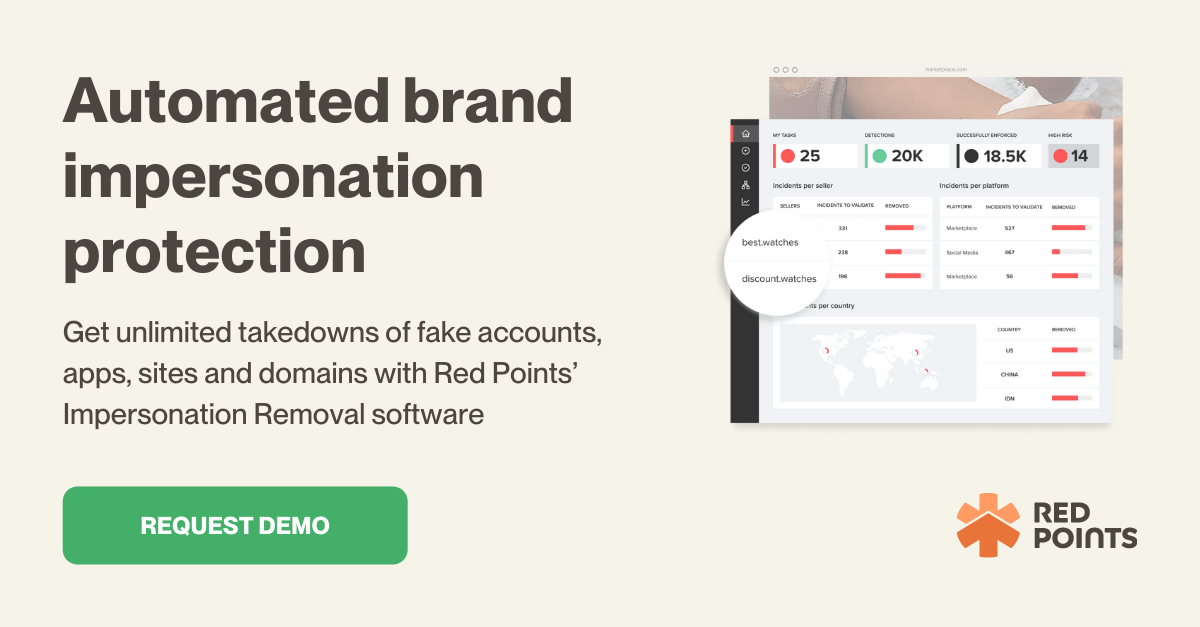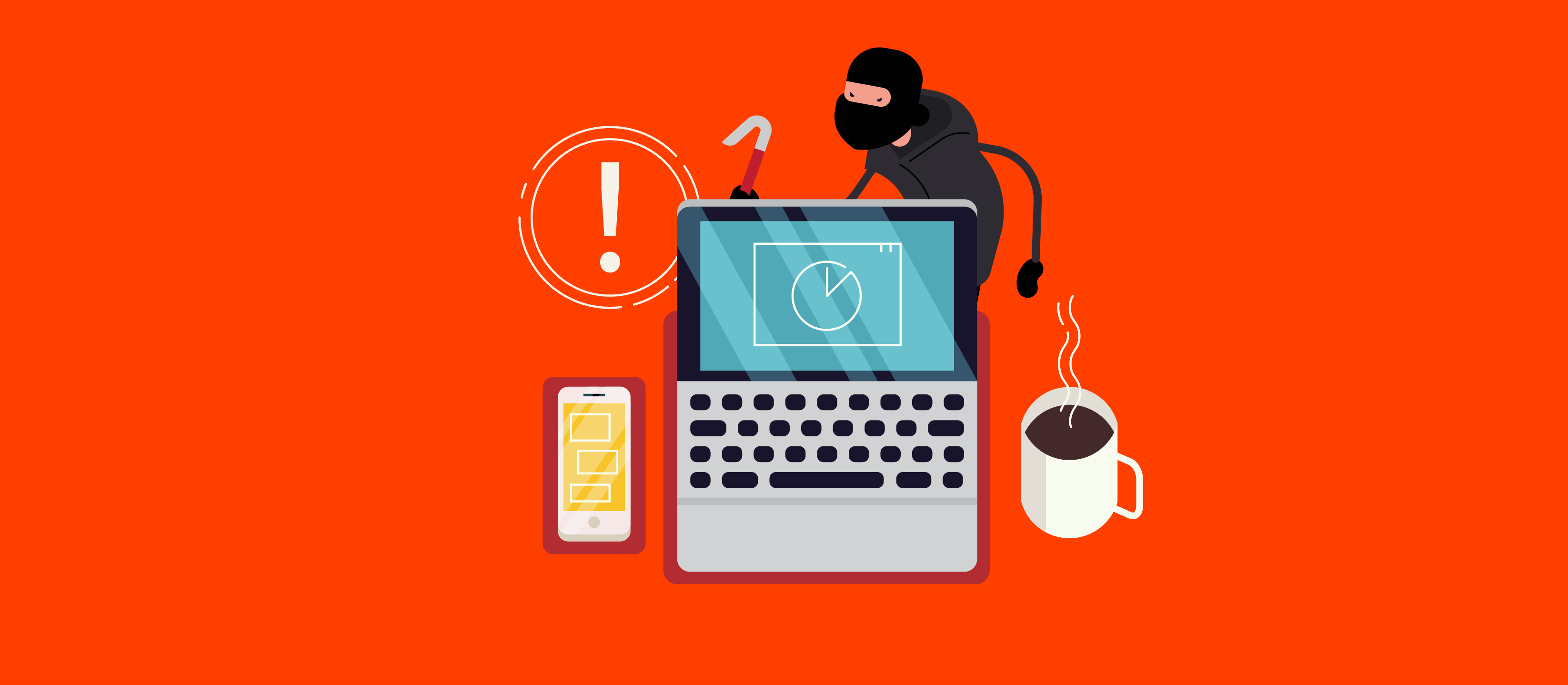Unwitting victims are the target of “bad actors” on the internet in schemes known as cyber scams. Cyber scams are a type of targeted cybercrime which entail anything from stealing the victim’s personal information to selling their victims fake or counterfeit products online.
This article aims to raise awareness about cyber scams and how brands or organizations might benefit from a pre-emptive plan to minimize possible frauds that may impact their reputation or target their consumers.
What is a cyber scam?
A cyber scam is the use of online services and software with an internet connection to deceive or exploit people. If you’re referring to criminal behavior that occurs online or over email (such as identity theft, phishing, and other hacking activities), the phrase “cyber scam” is the umbrella that many of these fall under.
Millions of dollars are lost each year by innocent people and businesses as a result of these internet scams that prey on unsuspecting victims.
Between January 2021 and December 2021, Barracuda Networks researchers evaluated millions of emails from thousands of enterprises. There was a 350% increase in the number of social engineering assaults on employees in small businesses (those with fewer than 100 workers) compared to those in large corporations.
Fortunately, state and federal authorities pursue criminal charges for cyber scams. 18 U.S.C. 1343, which governs general cyber fraud, can entail a sentence of up to 30 years in prison and penalties of up to $1 million, depending on the seriousness of the offense. Anti-phishing, credit card fraud, illegal computer access, and identity fraud legislation are also in place in states like California. Additionally, under the Anti-Phishing Act of 2005, it also happens to be illegal to appear as a legit company in order to get someone’s Personally Identifiable Information (PII).
Examples of common cyber scams
Some of the popular kinds of cyber scams are as follows:
Email phishing scams
These email-based phishing schemes continue to represent a severe threat to internet users and organizations.
According to estimates from Security Boulevard, phishing attacks accounted for 22% of all data breaches in 2020, while spear phishing accounted for 95% of all assaults on corporate networks. Ultimately, this report found that:
- 97% of users couldn’t identify an advanced phishing email.
- Cybercriminals developed 1.5 million new phishing sites every month.
- 78 percent of users were aware of the dangers of clicking on links in emails yet still did so.
- Email-based phishing schemes are continually changing and can range from simple assaults to more sophisticated and targeted threats.
In email phishing schemes, criminals often assume the identity of someone the target knows or trusts, in order to gain their trust and let people lower their guard before being defrauded. These attacks typically aim to get individuals to open a malicious file or click on a link that takes them to a malicious or faked website that may seem authentic to an unsuspecting victim.
These hackers initially take advantage of valid websites or build fake ones. A list of email addresses is compiled, and an email with a link to the website in question is sent to the recipients. After clicking the link, the victim is sent to the fake website, where they are prompted for their username and password or are inadvertently infected with malware that steals their data and login credentials.
The hacker can use this information to access the user’s online accounts, steal other personal information like credit card numbers, or gain access to business networks tied to the device.
Email phishing scam perpetrators frequently ask their victims for immediate attention. Telling them that their online account or credit card is in danger and that they must log in immediately to fix the problem.
Ransomware
There are other types of malware and criminality, but ransomware is one of the most pernicious. Once a victim falls for this type of scam a ransom is demanded in order to unlock the victim’s data on computer networks, mobile devices, and servers that are associated with that computer, meaning that these scams can cripple entire businesses until the ransom is paid off.
Individuals, businesses, and organizations, such as hospitals, governments, and educational institutions, are common ransomware victims. Currently, crypto-ransomware and locker ransomware are the two most common forms that these scams take because the transactions are less easy to track.
However, there are several varieties of ransomware. These attacks are often carried out using phishing scams. To get the receiver to open an attachment or download a file, a well-crafted email is required to accomplish so. Installing vector ransomware, which takes over the computer and can spread to the entire network, locks everyone out of their computers, the network, and other linked devices.
If the ransomware is successful, it can force the victim to pay a certain amount in order to free their files. A ransomware attack’s perpetrators will often demand payment in bitcoin, as these transactions tend to be difficult to trace. Once the payment is cleared an unlock code or decryption file releases the data on the network, mobile device, or servers from being held, hostage.
Fake anti-virus
Fake security software, sometimes known as scareware, is a common problem. Cybercriminals often use the promise of “Free Anti-Virus” to trick their victims into installing malware on their devices. Pop-up warnings that you have a virus are the first step in many of these scams, but they tend to be more common on unsafe or suspicious websites. The popup then misleads the user to assume that the fake anti-virus software will ‘remove the virus’ if they click on the link.
Mobile scams
Phishing applications are by far the most popular type of mobile scam, although there are many more variations. Phishing emails are similar to how these programs are made in that they are designed to fool customers into thinking they are using the real platform when it is actually an imitation. It is precisely the same principle, except instead of emails, the virus is sent through phony software. Although, emails are often still used in this scheme because many of these apps are not cleared to be on any of the major app hubs like the Apple App Store or the Google Play Store.
3 major ways cybercrime impacts business
Businesses are growing increasingly exposed to cyber criminals as they keep more of their and their customer’s data online. The rising expense of cyber security measures taken in response to increasing threats from cyber criminals may be passed on to customers.
Here are a few examples of how cybercrime is affecting businesses today.
1. Increased costs
Companies who wish to be safe from cyber theft must spend money to do so. Expenses may include, but are not limited to:
- Expertise and technology in cyber security.
- Notifying the impacted parties of a security breach.
- Cost of insurance.
- Support for public relations.
Another significant financial strain can be caused by ransomware, which prevents employees from using IT systems until the organization pays the perpetrator. 6% of corporations paid ransoms in 2019, resulting in $381 million in damages, according to Hiscox insurance.
To stay on the right side of cybersecurity legislation, firms may also need to retain legal counsel and other expertise, as they can be held liable if their customers’ private information is compromised in any way by hackers.
147 million consumers were affected by a 2017 data breach at Equifax, one of the three major credit reporting agencies. Since then the corporation has agreed to pay up to $425 million in damages to help those who were harmed by the data leak.
2. Damage to your brand’s reputation
Cyberattacks have a significant impact on the general public and, in the case of major enterprises, on the auxiliary businesses that support them. As a result, people are paying more attention to what is happening with their personal data than ever before.
In a poll conducted by the cybersecurity-focused audit and assurance firm PricewaterhouseCoopers (PwC), 69% of customers said they were concerned that the firms they use were vulnerable to hacking and assault by cyber criminals.
Even if a data breach happens, 87% of consumers are prepared to leave and shop elsewhere. Consumers are not just wary of companies that have access to their personal information, but they are also prepared to quit a firm that has a data breach. Organizations must set rules to safeguard their network from bad actors while retaining their relationship with customers, as consumers are aware of both.
3. Lost revenue
One of the worst outcomes of a cyberattack is a sudden drop in revenue, as cautious customers move elsewhere to protect themselves and their personal data from being leaked.
There has been a noticeable increase in cybercrime over the last year, according to the FBI’s annual Internet Crime Complaint Center (IC3) report.
There were 847,376 complaints in the last year, up from 791,790 in 2020, a rise of 7%. The amount of money that was lost due to complaints rose as well, from $4.2 billion the year before to $6.9 billion in the most recent year. The majority of the complaints arise from cons, such as extortion, identity theft, and data breaches.
Scams known as business email compromise (BEC), in which executives’ emails are impersonated after the company’s email accounts have been hacked, continue to be the biggest problem in the industry. There was an increase of $2.3 billion in BEC scams, compared to the previous year’s $1.8 billion.
Emails are being hacked and employees are being tricked into joining fake virtual meeting platforms by attackers, according to the FBI. To trick their victims into sending money through wire transfer or cryptocurrency, attackers purporting to be a CEO or CFO would declare that their audio/visual equipment is malfunctioning if an employee joins the call.
Unfortunately, many of these scams succeed despite seeming farfetched because once your private information is compromised it’s difficult to stop the hacker. In the United States of America, businesses lost a total of $2.4 billion to the two distinct forms of cons discussed above in the past year.
Where to report cyber scams?
The FBI is the primary government agency for federal investigations of cyberattacks and intrusions. They gather and disseminate information and interact with victims as they attempt to identify those responsible for cybercrime, no matter where they are.
You can contact these government agencies if you become a victim of an internet-related scam:
Your local field office of the FBI: If you or your company is the victim of a network intrusion, data breach, or ransomware assault, contact your local FBI field office or visit tips.fbi.gov to file a complaint.
Econsumer.gov: Report instances of international fraud. This organization accepts complaints about online purchasing and international e-commerce transactions. More than forty consumer protection agencies worldwide have formed a partnership.
Center for Internet Crime Complaints (IC3): Immediately register a report with the Internet Crime Complaint Center (IC3) if you have been the victim of an online or internet-enabled crime. The goal of crime reports is for investigation and intelligence gathering. Additionally, timely reporting might aid in the recovery of misplaced funds. Visit ic3.gov for more information, including current crime trends and prevention methods.
Federal Trade Commission: For the United States only. Complaints from consumers and information on internet fraud are shared with all levels of law enforcement.
Europol: For Europe. Several European nations are mentioned with direct URLs and email addresses where you can report internet fraud.
How can you prevent cyber scams?
Remaining vigilant of the most frequent kinds of cybercrime can help internet users avoid falling prey to cyber scams.
Don’t give out personal or financial information to anybody you meet online, and don’t click on links or files in emails or instant conversations that appear suspicious. Scammers and phishers should be reported to the police as soon as possible if they target internet users.
You may prevent credit card fraud by checking bank accounts to see if you’re the victim of a bank impersonation scam, setting up alerts for credit card activity, signing up for credit monitoring, and employing consumer protection services. If a user’s credit card is fraudulently used, they must notify the appropriate authorities and credit reporting agencies.
Some steps you can take are:
1. Have a strategy in place in the event of an emergency
You may help your team’s reaction to a cyber crisis by implementing effective rules, procedures, and processes. Check to make sure everyone understands their roles and how to respond in case of an emergency. You’ll also be able to maintain your firm in compliance with new laws if you keep this plan current. Testing the strategy through mock exercises is also vital, as is including all relevant stakeholders to verify that everyone understands and can execute their role in case of an emergency.
2. Increase workplace safety awareness
The first line of protection against cybercrime as a business owner is your employees. Regular educational seminars and training are the most effective means of empowering them while also securing your business’s data. As a result of the right training provided by the company, employees will be able to spot any cybersecurity risks and report them rather than falling victim, ultimately preventing data breaches.
3. Organize your data in an efficient manner
Knowing what kind of data your business has is the first step in protecting and storing it securely. Begin categorizing the material to decide what level of security is needed, once this is determined you can assign certain levels of security to specific types of data; for instance, customer financial information might be a top security priority and receive more layers of security than some less important data.
Fortunately, there are professionals in data security that are able to help with this type of work. If you’d want an unbiased opinion on whether your governance, security, and risk management procedures are doing their job, a vulnerability assessment by a professional adviser can help.
4. Reduce exposure to risk from unaffiliated third parties
The scope of cyber security extends well beyond the PCs of your staff. Third-party vendors, suppliers, and any other parties that have access to your or your customer’s data represent a risk. You must do periodic reviews of third-party cybersecurity to see whether any of them pose an unacceptable danger to your organization. Also, consider risk-ranking your third parties in order to guarantee that the most critical suppliers are reviewed more rigorously and regularly.
5. Create a position for a cybersecurity protection officer
A company’s cyber strategy must be consistent with regulatory requirements and up to date on the newest external dangers if it is going to be effective. In order to keep the company as safe as possible, the individual tasked with developing this strategy must maintain a prepared incident response team that is well-versed in the company’s safety regulations. To guarantee that your customers, business partners, and potential investors are aware of the robust cybersecurity protection posture you have put in place, this individual should have a distinct title and function as the primary external communicator.
6. Consult with reliable advisors
When it comes to cybersecurity, the best offense is a good defense. Your business can mitigate the risk of a breach or incident by preemptively enhancing your organization’s cyber resilience. Customers and investors now expect cyber security as a minimum necessity. In times of crisis, having a team of trustworthy experts on your side will reduce stress and limit panic will be an incredible asset.
7. Utilize impersonation removal software
Fortunately, with the use of modern technology, brands can also offensively target and report scammers that are using their likeness as part of their scam. Using premier machine learning technology, such as Red Points’ Impersonation Removal Software, brands can defend your brand against fake social media accounts, stand-alone websites, and lookalike applications with limitless takedowns. This not only protects your brand from potential customer complaints from those who were scammed, but it also can reduce the likelihood of any employees incidentally entering confidential information on a fake site that is a clone of your business.
All possible infringements may be logged on the Red Points platform so that companies can monitor and evaluate findings, validate infringements and protect themselves or their brand against future brand impersonation.
What’s next
Cybercrime has swiftly risen to the top of the list of today’s most prevalent criminal activities. To put this into perspective, the FBI reported that more than $3 billion was lost to cybercrime in 2019 alone, however, since the Covid-19 Pandemic, cybercrime has increased drastically as a result of increased reliance on ecommerce.
Small businesses are now the target of 43% of internet attacks, making them a prime target for cybercriminals, but only 14% of small business owners are prepared to protect themselves.
Take protection into your own hands using Red Points’ Impersonation Removal Software and proactively take down any cyber scam targeting your business or its customers before they are able to do any harm.






